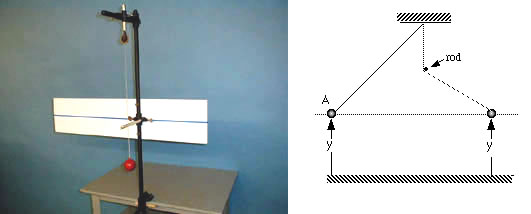Demos: 1M-02 Galileo Pendulum

This demonstration is useful in clarifying the definition of work. A pendulum is released from rest. At the bottom of its path the string strikes a rod, causing the pendulum to swing in a smaller arc. The pendulum still reaches the same elevation it started from.
Directions: First hold the ball level with the white horizontal line, but remove the rod. The pendulum bob will reach the same height (white line) on the other side. Now insert the rod and repeat. The bob still reaches the same maximum height. This is a case of conservation of mechanical energy because the rod does no work on the ball. (Note: The rod should be high enough that the pendulum reaches a maximum height associated with v = 0.
If the rod is too low, mechanical energy is still conserved, but the ball will reach a lower maximum height, requiring it to have some kinetic energy. In this case the ball will wrap around the rod.)
Suggestions for Presentation: Stand well to the side so that students can see the ball’s path. Have them focus on the end point each time. Once you have established that mechanical energy is conserved, show in slow motion (carrying the ball with your hand) that if the bar is quite low, the bob can’t get back to the initial height. How does energy get conserved in this case?
Applications: None
Last Updated: Nov 30, 2023 11:25 AM